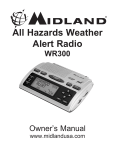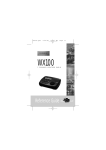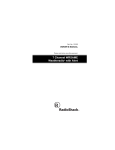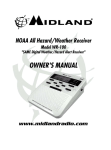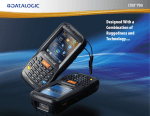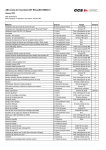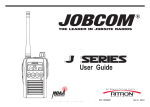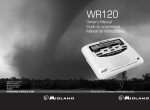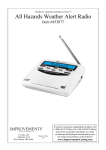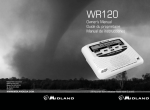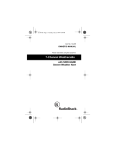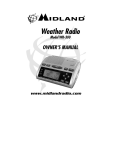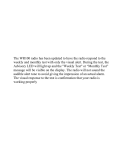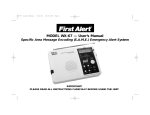Download Uniden WX500 Specifications
Transcript
WX500 web OM final.qxd 07/15/2002 4:30 PM REFERENCE GUIDE Page 1 WX500 web OM final.qxd 07/15/2002 4:30 PM Precautions Before you read anything else, please observe the following: Uniden DOES NOT represent this unit to be waterproof. To reduce the risk of fire or electrical shock, DO NOT expose this unit to rain or moisture. Changes or modifications to this product not expressly approved by Uniden, or operation of this product in any way other than as detailed by this Reference Guide, could void your authority to operate this product. Page 2 WX500 web OM final.qxd 07/15/2002 TABLE OF CONTENTS Introduction . . . . . . . . . . . . . . . . . . . . . . . . . . . . . . . 1 About Your Radio . . . . . . . . . . . . . . . . . . . . . . . 1 About Emergency/Weather Alerts . . . . . . . . . . . 2 About FIPS Codes . . . . . . . . . . . . . . . . . . . . . . . 3 Obtaining Your Areas FIPS Code(s) . . . . . . . . . 4 Taking Proper Care of Your Radio . . . . . . . . . . 5 Unpacking . . . . . . . . . . . . . . . . . . . . . . . . . . . . . 5 Getting Started . . . . . . . . . . . . . . . . . . . . . . . . . . . . . 6 Setting Up the WX500 All Hazards/ Weather Radio . . . . . . . . . . . . . . . . . . . . . . . . . 6 Battery Backup . . . . . . . . . . . . . . . . . . . . . . . . . . 8 Controls & Functions . . . . . . . . . . . . . . . . . . . . 9 Initial Settings. . . . . . . . . . . . . . . . . . . . . . . . . . . . 11 Clock Setting. . . . . . . . . . . . . . . . . . . . . . . . . . . 12 Alarm Clock Setting . . . . . . . . . . . . . . . . . . . . . 13 NWS Broadcast Channel Setting . . . . . . . . . . . 14 FIPS Code Setting . . . . . . . . . . . . . . . . . . . . . . 15 Alert Type Setting . . . . . . . . . . . . . . . . . . . . . . . 17 Backlight Setting . . . . . . . . . . . . . . . . . . . . . . . 19 Operation . . . . . . . . . . . . . . . . . . . . . . . . . . . . . . . . 20 Using the All Hazards/Weather Radio . . . . . . . 20 Testing the Weather Alert Radio. . . . . . . . . . . . 24 Troubleshooting . . . . . . . . . . . . . . . . . . . . . . . . . . . 25 Technical Specifications . . . . . . . . . . . . . . . . . . . . . 26 One-Year Extended Warranty . . . . . . . . . . . . . . . . . 27 4:30 PM Introduction Getting Started Initial Settings Operation Troubleshooting Specifications Page 3 WX500 web OM final.qxd 07/15/2002 4:30 PM INTRODUCTION About Your Radio Traditional weather radios receive NOAA's weather broadcast (usually within a 50-mile radius) then sound an alarm of any emergency code which was transmitted along with the broadcast. This means that people who live outside an affected area are often alerted even when their area is not affected, causing many of them to ignore potentially real emergency/weather warnings that can save lives. In 1994, the National Oceanic and Atmospheric Administration (NOAA) began broadcasting coded signals called FIPS (Federal Information Processing System) codes along with their standard weather broadcasts from stations in your area. These codes identify an emergency and the specific geographic area (such as a county) affected by the emergency. The WX500 was developed with the S.A.M.E. (Specific Area Message Encoding) technology. This allows your radio to receive, interpret, and display the information about the codes so you can determine if the emergency might affect your area. Only S.A.M.E. compatible emergency/weather radios are able to take advantage of this new technology. Each FIPS code identifies a specific geographic area (defined by the National Weather Service), so your radio sounds an alert only when an emergency/weather emergency is declared in those locations. This helps you more efficiently track the emergency/weather conditions in and around your area. 1 Page 1 WX500 web OM final.qxd 07/15/2002 4:30 PM Your new radio is equipped with the following features: ■ ■ ■ ■ ■ ■ ■ ■ ■ 7 Preprogrammed National Weather Service Broadcast Channels Programmable Emergency/Weather Alert with S.A.M.E. Technology Liquid Crystal Display for Alert Description Backlit Display 20 Programmable Area Codes 3 Alert Modes (Display, Tone, Voice) Multiple Alert Display Capability Alarm Clock with Snooze Battery Backup Power Source About Emergency/Weather Alerts When the WX500 receives an emergency/weather alert: It sounds an alert tone. A description of the alert appears. An indicator on the front of the radio illuminates. If the radio receives more than one emergency/weather alert at the same time, it displays information about each alert. The alert descriptions your radio can display are based on a list of specific emergency/weather alert types published by the NWS. For a list of all the alert descriptions that your radio can display, see NWS Emergency/Weather Alert Event Code descriptions on pages 22 - 23. Caution: The NWS uses sophisticated models to determine an alerts effective time. However, the end of an alert does not necessarily mean that the related emergency is over. 2 Page 2 WX500 web OM final.qxd 07/15/2002 4:30 PM About FIPS Codes For the purpose of broadcasting emergency/weather information, the NWS has divided the United States into regions by state and county (or parish, where applicable) then assigned a 6-digit FIPS code to identify each county or parish. For example, the code for Tarrant County, Texas, is 048439. The first digit in a FIPS code identifies the county subdivision, the next two digits identify the state, and the last three digits identify the county or parish. Most FIPS codes begin with 0, which means that FIPS code represents an entire county. The NWS, however, eventually plans to subdivide some large counties. When that happens, each subdivision will be assigned a digit from 19, resulting in codes such as 148439, 248439, and so on. Your radio can receive all S.A.M.E. alert signals broadcasted within about a 50-mile radius of where you installed it. To receive S.A.M.E. alerts and broadcasts about emergencies/weather occurring only in particular counties within that area, you can program up to 20 FIPS codes into the radios memory. For example, this lets you avoid hearing an alert that applies to an area within a 50-mile radius but not necessarily to your county or parish. 3 Page 3 WX500 web OM final.qxd 07/15/2002 4:30 PM Obtaining Your Areas FIPS Code(s) To obtain the FIPS code for the location where you installed your radio, contact the NWS toll free at 1-888-NWR-SAME (1-888-697-7263). Visit their website: http://www.nws.noaa.gov/nwr/indexnw.htm If you call the NWS, follow the instructions you hear. If you are close to a county or parish line, you might want to obtain the codes for the nearby counties or parishes. Hint: Since you can program up to 20 FIPS codes into the radios memory, you might want to obtain the codes for other local areas (as long as those areas are within a 50 mile radius of your local NWS broadcast station). That way, you can program those codes into the radio and receive broadcasts covering those locations, too. 4 Page 4 WX500 web OM final.qxd 07/15/2002 4:30 PM Taking Proper Care of Your Radio ■ ■ ■ Do not use the radio in high-moisture environments such as the kitchen or bathroom. Avoid placing the unit in direct sunlight, near heating elements, or vents. Do not plug the radio into an outlet controlled by a wall switch as prolonged periods without power causes the clock to reset. Unpacking Carefully check the contents against this list: ■ ■ ■ ■ WX500 Radio with built-in telescopic antenna AC Adaptor (Model AC500) Cigarette Lighter Adaptor (Model DC500) This Reference Guide and other printed materials ☞ ☞ ☞ 5 If any items are missing or damaged, contact the Uniden Parts Department at (800) 554-3988. Hours are from 7:00a.m. to 5:00p.m. Monday through Friday, Central Time. We may also be reached at: www.uniden.com. Complete and mail your Registration Form immediately. Read this Reference Guide thoroughly before operating the radio. Page 5 WX500 web OM final.qxd 07/15/2002 4:30 PM GETTING STARTED Setting Up the WX500 All Hazards/Weather Radio 1. Plug the AC adaptor into an outlet and into the WX500. Make sure that the outlet is not controlled by a switch that is turned OFF. 2. Install the 9V Backup Battery by removing the battery compartment cover and snapping the battery onto the terminals. 3. If you would like to program your radio to receive Alerts only for certain areas, determine the SAME codes you need. SAME codes for your area can be found using the National Weather Service toll-free phone number or the NOAA website. Phone: 1-888-NWR-SAME (1-888-697-7263) Web: http://205.156.54.206/nwr/indexnw.htm (a branch from http://www.nws.noaa.gov/nwr) NOTE: If the radio will be located close to a county or parish boundary lines, you may want to program SAME codes for the nearby areas. 6 Page 6 WX500 web OM final.qxd 4. 7 4:30 PM Determine the best Emergency/Weather Channel to use in your area. The best channel for your area is listed on the NOAA website at: http://205.156.54.206/nwr/indexnw.htm along with the SAME codes, or at http://205.156.54.206/nwr/nwrbro.htm. Or, you can turn the Emergency/Weather Radio and NWR broadcast ON, enter the Menu, and change the CHANNEL until you find the broadcast with the best reception. Channel Number 1 2 3 4 5 6 7 5. 07/15/2002 NOAA Frequency (MHz) 162.550 162.400 162.475 162.425 162.450 162.500 162.525 Enter the Menu (menu key) and use the 3,4,5 ,6 and select key if you would like to change the user-programmed settings. Page 7 WX500 web OM final.qxd 07/15/2002 4:30 PM Battery Backup Battery backup capability allows the WX500 to operate for a limited time when AC power is not available. During AC power loss, all radio features are available, but turning the Emergency/Weather Radio OFF will conserve the battery. Remove the battery if the WX500 will not be plugged in for an extended period of time. Without AC or Battery Backup power, the Clock time will be lost, but all other programmed information will be kept. WX500 will sound a Low Battery tone at the time that a low battery condition is detected. After the tone, the Low Battery Icon will turn ON to indicate that the Backup Battery needs replacement. 8 Page 8 WX500 web OM final.qxd 07/15/2002 4:30 PM Controls & Functions 1. LCD Display Displays time, channel, frequency, and functions. 2. Green Indicator Indicates that a Statement type of alert broadcast is in effect. Refer to the alert table for details. 3. Yellow Indicator Indicates that a Watch type of alert broadcast is in effect. Refer to the alert table for details. 4. Red Indicator Indicates that a Warning type of alert broadcast is in effect. Refer to the alert table for details. 5. Antenna 9 6. 5 6 Key With more than one NWR Alert active, forces a change of the display to the next active Alert. During Menu operation, changes the current Menu item. 7. 34 Key While setting the Clock time, the Alarm time, or a SAME code during Menu operation, moves to the previous/next field (for example, moving from Minutes to AM/PM). 8. menu Key Enters and exits the Main Menu. Returns to a previous menu while using Sub-menus. 9. select Key During Menu operations, selects the current menu or accepts the current setting. 10. weather/snooze Turns the NWR broadcast (speaker) ON and OFF. When Alarm Clock tones are being heard, stops the tones Page 9 WX500 web OM final.qxd 07/15/2002 4:30 PM and sets the Alarm Clock tones to start again in 8 minutes (press any other key to reset the Alarm until the alarm time is reached again). 11. volume/on/off Turns the Weather Radio's receiver ON and OFF. Sets the Volume level for NWR broadcasts. The receiver must be ON in order to use the Weather button or to receive alerts. 12. Speaker NOTE: If the Emergency/Weather Radio is turned OFF while alert messages are active, the active alerts will be deleted. NOTE: When the WX500 is sounding NWR Alert tones, buttons do not perform their normal functions. Instead, they stop the Alert tones. 1. 14-Segment Characters : Displays Time, Alert information, and Menus 2. Low Battery Icon : Indicates when the Backup Battery needs to be changed. 3. Menu Icon : Indicates Menu programming is active. 4. NOAA Icon : Shown when the Weather Radio receiver is ON, extinguished when the Weather Radio is OFF. 5. Tone Icon : Indicates that the Alert Method is set to TONE. 6. Voice Icon : Indicates that the Alert Method is set to VOICE. 7. Alarm Icon : Indicates that the Alarm Clock is set to sound Alarm tones. If the NOAA icon is ON but the TONE and VOICE icons are OFF, the Weather Receiver is available (ON) for listening to NWR broadcasts and the Alert Method is DISPLAY (Alerts will be displayed, but no Alert tones will be sounded). 10 Page 10 WX500 web OM final.qxd 07/15/2002 4:30 PM Initial Settings There are six menu options that you must set up prior to proper operation. To do this, press the menu key. Use the 5/6 keys to change the six menu options. Setting Default Clock Time (TIME) 12:00 AM Alarm (ALARM) OFF Channel (CHANNEL) 1 (162.550 MHz) SAME code (SAME SET) ANY Alert type (ALT TYPE) VOICE Backlight mode (LIGHT) SAVE To exit the menu mode, press menu repeatedly. Each of these options are described in more detail following this introduction. 11 Page 11 WX500 web OM final.qxd 07/15/2002 4:30 PM Clock Setting When you first apply power or when there is a power outage without the battery backup, the current time on the display will not be correct. To set the current time: 1. Press menu. 2. TIME appears on the display. 3. Press select. 4. Enter the time by pressing the 3, 4, 5, and 6 keys. 5. Press select to complete the entry. The display goes back to the Menu mode. 12 Page 12 WX500 web OM final.qxd 07/15/2002 4:30 PM Alarm Clock Setting As an additional feature, the WX500 has an audible alarm clock. Before setting this feature, set the clock to the current time. (See page 12.) 13 1. Press the menu key. 2. Press 5/6 until ALARM appears. 3. Press select for setting the Alarm Clock. 4. Press 5/6 to choose the Alarm Clock Setting. If you do not want to set the Alarm Clock, select OFF. The display goes back to the menu mode. 5. If you select ON; enter the time by pressing the 5/6 keys. To scroll more quickly (in 15 minute increments), press and hold 5/6 for more than 5 seconds. 6. To move to the next digit press 3/4. 7. To exit press the menu key. Page 13 WX500 web OM final.qxd 07/15/2002 4:30 PM NWS Broadcast Channel Setting Your radio is preprogrammed with the seven National Weather Service broadcast frequencies (Channel 1-7). Depending on your location, you may be able to receive more than one channel with clear reception. CH No. 1 2 3 4 5 6 7 Frequency (MHz) 162.550 162.400 162.475 162.425 162.450 162.500 162.525 The first time you use your radio, Channel 1 (162.550 MHz) is automatically set as your emergency/weather channel. Depending on your location, you may be able to receive this channel. To check or change channels, perform the following steps. 1. 2. 3. 4. 5. 6. 7. 8. Turn the on/off/volume control until it clicks. The NOAA icon will appear in the display. Press weather/snooze. Adjust the volume control to a comfortable listening level. You may hear the emergency/weather broadcast on the initially selected channel. If not or if you wish to select another channel, continue on. Otherwise stop here. Your channel is set. Press menu. Press 5/6 until CHANNEL appears. Press select. Press 5/6 to scroll through the list of channels. The channel number and the corresponding frequency appear in the display. If you receive more than one channel, select the one that has the clearest audio. Press select again to complete the entry. 14 Page 14 WX500 web OM final.qxd 07/15/2002 4:30 PM FIPS Code Setting The 6-digit Federal Information Processing System (FIPS) code established by the National Weather Service (NWS) identifies geographic areas in the United States. Programming FIPS code is necessary to receive S.A.M.E. alerts about emergencies/weather occurring in a particular area. To set FIPS codes: 1. Press menu and toggle 5/6 until SAME SET appears in the display. 2. Press select. 3. Press 5/6 to select SINGLE, MULTIPLE, or ANY. or: If you select ANY, press select. This completes the entry. The display returns to menu mode. If you select SINGLE, a) Press select. Then enter the FIPS code that you want to be monitoring. b) Press select and the display returns to menu mode. If you select MULTIPLE, a) Press select. SAME 1 appears in the display. If you do not want to see or change the first FIPS caode, use 5/6to choose another location. b) Press select again and the first digit of the FIPS code starts flashing, indicating that the code is ready to be edited. c) Press the 5/6, 3/4 keys to enter the code and press select again. d) Repeat the above steps in any or all memory locations using the 5/6 to select another location. e) To exit this mode, press menu key until SAME SET appears in the display. 15 Page 15 WX500 web OM final.qxd 07/15/2002 4:30 PM Option Description: ANY FIPS SINGLE MULTIPLE 6. When this option is selected, your radio receives the alert signals of any FIPS codes whether you have programmed them or not. When this option is selected, your radio only receives the alert signals corresponding to the FIPS code that you enter. When this option is selected, your radio receives the alert signals corresponding to the FIPS code that you program in any of the 20 memory locations. To turn OFF the radio, turn the on/off/volume control until it clicks. Your radio will continue to function as an Alarm Clock. The selected settings remain for the next time the radio is turned ON 16 Page 16 WX500 web OM final.qxd 07/15/2002 4:30 PM Alert Type Setting When the All Hazards/Weather Radio is ON, this setting determines how WX500 will communicate screened NWR Alert messages. For all three selections, the 5 most recent Alerts, along with Severity and Time of the Message Expiration, will be shown on the display. DISPLAY: Upon receiving a screened NWR Alert, only the Alert and Alert Severity displays will be affected. No Alert tones will sound and the broadcast will not be heard unless you press the weather/snooze key. 17 VOICE: Upon receiving a screened NWR Alert, an alert tone will sound for about 8 seconds. After the alert tone, the WX500 will automatically turn ON the emergency/weather broadcast (speaker). You will hear the broadcast until the NWR End-of-Message code is received or until you turn the broadcast OFF. The WX500 automatically selects the VOICE Alert Type the first time you turn it ON. TONE: Upon receiving a screened NWR Alert, an alert tone will sound for up to 15 minutes. A press of any key will stop the Alert tone. The broadcast will not be heard unless you press the weather/snooze key. Page 17 WX500 web OM final.qxd 07/15/2002 4:30 PM To change the Alert Type setting, see the following steps. 1. Press the menu key 2. Press 5/6 until ALT TYPE appears on the display. 3. Press the select key. 4. Press 5/6 to choose TONE, VOICE or DISPLAY. 5. Press the select key again. 6. Press menu to exit. The Alert Type setting you selected will determine the Alert Type icon on the display. If you selected the TONE Alert Type alert, the following icon will be displayed. If you selected the VOICE Alert Type alert, the following icon will be displayed. If you selected the DISPLAY Alert Type alert, the following icon will be displayed. To silence the tone, press any key. 18 Page 18 WX500 web OM final.qxd 07/15/2002 4:30 PM Backlight Setting The initial setting for the display backlight is SAVE, which means the backlight stays on for 10 seconds. You can change this setting by following the steps below: 1. Press the menu key. 2. Press 5/6 until LIGHT appears on the display. 3. Press the select key for the Backlight Settings. 3. Press 5/6 to select OFF, SAVE, CONST-LO, or CONST-HI. OFF The LCD backlight will never be illuminated. SAVE The LCD backlight will turn on (bright) for 10 seconds following a new NWR Alert or following a user key-press. CONST-LO The backlight will stay on dimly most of the time but will switch to bright for 10 seconds following a new NWR Alert or following a key press. CONST-HI The backlight will always stay on brightly. 4. Press the select key. 5. To exit the menu mode, press menu. The CONST-LO and CONST-HI settings can significantly affect battery life while operating with the BATTERY ONLY. If the adaptor power is lost, it is recommended to change the Backlight mode to OFF or SAVE. 19 Page 19 WX500 web OM final.qxd 07/15/2002 4:30 PM OPERATION Using the All Hazards/Weather Radio Your radio functions as an all hazards/weather warning radio. This is especially useful when your area is expecting severe weather conditions any time of day. It emits a loud tone whenever your local NOAA weather station broadcasts a severe emergency tone. You have the option of listening to the emergency/weather broadcast or not. Even though you may not be listening to the broadcast, the radio still responds to the emergency tones from the local weather station. To turn ON the emergency/weather alert radio: 1. Turn the on/off/volume until it clicks. The NOAA icon appears in the display. 2. Press weather/snooze until you hear the weather broadcast. OR If you do not want to listen to the emergency/weather broadcast, press weather/snooze again. The receiver is actually still ON but the audio is muted. 3. Make sure you adjust your volume control to a comfortable listening level. If you have set the Alert Type to VOICE, the volume level of the voice broadcast, when it comes on, will be set correctly. The volume control only adjusts the audio of the broadcast, not the siren volume. 20 Page 20 WX500 web OM final.qxd 4. 07/15/2002 4:30 PM The last five, non-expired, Alerts will scroll across the LCD one at a time. Each Alert will be displayed with its appropriate Severity indicator and with the time until the Alert message expires. You can force the WX500 to quickly skip to the previous/next Alert by using the 5/6 keys. Stop Alert tones by pressing any key. The NWS uses sophisticated models to determine an Alert's expiration time. The expiration of an Alert, however, does not necessarily mean that the related emergency is over. This is particularly true for longer duration Alerts because Alert expiration times are limited to 6 hours in the NWS protocol. 21 Page 21 WX500 web OM final.qxd 07/15/2002 4:30 PM The following is a list of Event codes transmitted by the National Weather Service. When a specific Event code is received, this chart indicates the displays as they alternately appear on the display with the corresponding Alert Type indicator, and the Alert Type tone of the siren. Event Codes Event Code AVW AVA BZW CDW CDA CEM CFW CFA EAN EAT EVI FRW FFS FFW FFA FLS FLW FLA HMW HMA HWW HWA HLS HUW HUA IEW LEW Display 1 AVALANCH AVALANCH BLIZZARD CIVIL CIVIL CIVIL COASTAL COASTAL EMERGENC EMERGENC EVACUATE FIRE FLASH FLASH FLASH FLOOD FLOOD FLOOD HAZARD HAZARD HIGH HIGH HURRICAN HURRICAN HURRICAN IMMEDIAT LAW Display 2 Display 3 DANGER DANGER EMERGENC TUNE TV FLOOD FLOOD ACTION ACTION TERMINAT IMMEDIAT FLOOD FLOOD FLOOD MATERIAL MATERIAL WIND WIND EVACUATE ENFORCE LED Alert Siren Red Yellow Red Red Yellow Red Red Yellow Red Red Red Red Green Red Yellow Green Red Yellow Red Yellow Red Yellow Green Red Yellow Red Red Warning Siren Watch Siren Warning Siren Warning Siren Watch Siren Warning Siren Warning Siren Watch Siren Warning Siren Warning Siren Warning Siren Warning Siren Statement Siren Warning Siren Watch Siren Statement Siren Warning Siren Watch Siren Warning Siren Watch Siren Warning Siren Watch Siren Statement Siren Warning Siren Watch Siren Warning Siren Warning Siren 22 Page 22 WX500 web OM final.qxd Event Code LAE NHW NIC NPT DMO RHW RHA RWT RMT SVR SVW SVA SVS SPW SMW SPS TOR TOW TOA TSW TSA VOW VOA WSW WSA ??E ??A ??W ??S 23 Display 1 LOCAL NATIONAL NATIONAL NATIONAL DEMO RADIOLOG RADIOLOG WEEKLY MONTHLY SEVERE SEVERE SEVERE SEVERE SHELTER SPECIAL SPECIAL TORNADO TORNADO TORNADO TSUNAMI TSUNAMI VOLCANO VOLCANO WINTER WINTER UNKNOWN UNKNOWN UNKNOWN UNKNOWN 07/15/2002 Display 2 Display 3 AREA HAZARD INFO PERIODIC MESSAGE HAZARD HAZARD TEST TEST THUNDER THUNDER THUNDER WEATHER IN-PLACE MARINE WEATHER EMERGENC Red Red CENTER Red TEST Green Red Yellow Red Red Yellow Green Red Red Green Red Red Yellow Red Yellow Red Yellow Red Yellow Red Yellow Red Green STORM STORM TUNE TV TUNE TV TUNE TV TUNE TV LED 4:30 PM Alert Siren Warning Siren Warning Siren Warning Siren Statement Siren None Warning Siren Watch Siren Statement Siren Statement Siren Warning Siren Warning Siren Watch Siren Statement Siren Warning Siren Warning Siren Statement Siren Warning Siren Warning Siren Watch Siren Warning Siren Watch Siren Warning Siren Watch Siren Warning Siren Watch Siren Warning Siren Watch Siren Warning Siren Statement Siren Page 23 WX500 web OM final.qxd 07/15/2002 4:30 PM Testing the Weather Alert Radio NWR stations conduct regular tests of Alert broadcasting. Tests normally occur on Wednesdays between 10AM and 12PM unless threatening weather is occurring. Your local station can be contacted to find out exact dates and times of tests. You should make sure your WX500 receives these Test Alerts in its installed location. This is very important because an emergency alert broadcast might not trigger your radio even when it seems to be receiving broadcasts fairly clearly. If broadcast signals are too weak, you might be able to receive Alerts in one part of a building but not another. 24 Page 24 WX500 web OM final.qxd 07/15/2002 4:30 PM TROUBLESHOOTING If your WX500 radio is not performing properly, try the following steps. If you are still unable to resolve the problem, contact your place of purchase or call customer service at (800) 297-1023. Problem Solution Check the connections at both ends of the AC Adapter. Turn on the wall switch of your room. You could be using an outlet controlled by the wall switch. Move the AC Adapter to another wall outlet. Move the antenna. Poor reception. Relocate the radio. Check if a stronger station is available in your area. You may be in a fringe area. Check reception. No Alert messages received. Make sure the on/off/volume dial is turned ON. If you have programmed a S.A.M.E. (FIPS) code, check that it is correct. Alerts received for all / Make sure that the Alert screening unwanted counties/parishes method is SINGLE or MULTIPLE and that the S.A.M.E. codes are correct. 'Erase' unwanted area codes by setting them to something like '000000' or '999999'. Weather broadcast is not Make sure the on/off/volume dial is heard when weather/snooze turned ON. button is pressed. Check that the channel is set to an active station. WX500 won't power up. 25 Page 25 WX500 web OM final.qxd 07/15/2002 4:30 PM TECHNICAL SPECIFICATIONS Frequency Coverage (MHz): Channel 1: Channel 2: Channel 3: Channel 4: Channel 5: Channel 6: Channel 7: 162.550 162.400 162.475 162.425 162.450 162.500 162.525 Receiving Sensitivity (at 12 dB SINAD): 0.35 mV FIPS Decode Sensitivity @ Dev. ±4.5 kHz Deviation/90 % Success Rate: 0.40 mV Signal & Noise Ratio: 40 dB Channel Selectivity: 45 dB Audio Output Power @ 10% THD: 250 mW Power Requirements: Use AC500 (adaptor included) with 120 V AC (±10%) 60 Hz or DC cigarette lighter adaptor Battery Back-up: One 9-Volt Alkaline Battery (not included) Antenna: Telescopic Rod Antenna (built-in) Dimensions: 127 (W) x 126 (D) x 48 (H) mm Weight: 245 g without AC ADAPTOR and 9 V Battery Specifications are typical; individual units might vary. Specifications are subject to change and improvement without notice. 26 Page 26 WX500 web OM final.qxd 07/15/2002 4:30 PM ONE-YEAR EXTENDED WARRANTY Important: Evidence of original purchase is required for warranty service. WARRANTOR: UNIDEN AMERICA CORPORATION (Uniden) ELEMENTS OF WARRANTY: Uniden warrants, for one year, to the original retail owner, this Uniden Product to be free from defects in materials and craftsmanship with only the limitations or exclusions set out below. WARRANTY DURATION: This warranty to the original user shall terminate and be of no further effect one year after the date of original retail sale. The warranty is invalid if the Product is (A) damaged or not maintained as reasonable or necessary, (B) modified, altered, or used as part of any conversion kits, subassemblies, or any configurations not sold by Uniden, (C) improperly installed, (D) serviced or repaired by someone other than an authorized Uniden service center for a defect or malfunction covered by this warranty, (E) used in any conjunction with equipment or parts or as part of any system not manufactured by Uniden, or (F) installed or programmed by anyone other than as detailed by the owners manual for this product. STATEMENT OF REMEDY: In the event that the product does not conform to this warranty at any time while this warranty is in effect, warrantor will either, at its option, repair or replace the defective unit and return it to you without charge for parts, service, or any other cost (except shipping and handling) incurred by warrantor or its representatives in connection with the performance of this warranty. Warrantor, at its option, may replace the unit with a new or refurbished unit. THE LIMITED WARRANTY SET FORTH ABOVE IS THE SOLE AND ENTIRE WARRANTY PERTAINING TO THE PRODUCT AND IS IN LIEU OF AND EXCLUDES ALL OTHER WARRANTIES OF ANY NATURE WHATSOEVER, WHETHER EXPRESS, IMPLIED OR ARISING BY OPERATION OF LAW, INCLUDING, BUT NOT LIMITED TO ANY IMPLIED WARRANTIES OF MERCHANTABILITY OR FITNESS FOR A PARTICULAR PURPOSE. THIS WARRANTY DOES NOT COVER OR PROVIDE 27 Page 27 WX500 web OM final.qxd 07/15/2002 4:30 PM FOR THE REIMBURSEMENT OR PAYMENT OF INCIDENTAL OR CONSEQUENTIAL DAMAGES. Some states do not allow this exclusion or limitation of incidental or consequential damages so the above limitation or exclusion may not apply to you. LEGAL REMEDIES: This warranty gives you specific legal rights, and you may also have other rights which vary from state to state. This warranty is void outside the United States of America. PROCEDURE FOR OBTAINING PERFORMANCE OF WARRANTY: If, after following the instructions in the reference guide you are certain that the Product is defective, pack the Product carefully (preferably in its original packaging). The Product should include all parts and accessories originally packaged with the Product. Include evidence of original purchase and a note describing the defect that has caused you to return it. The Product should be shipped freight prepaid, by traceable means, to warrantor at: Uniden America Corporation Parts and Service Division 4700 Amon Carter Blvd Fort Worth, TX 76155 (800) 297-1023, 8 a.m. to 5 p.m., Central Time, Monday through Friday 28 Page 28 WX500 web OM final.qxd 07/15/2002 4:30 PM THANK YOU FOR PURCHASING THIS UNIDEN PRODUCT! ©2002 Uniden America Corporation OMWX500 All rights reserved Printed in China Covered under one or more of the following U.S. patents: 4,597,104 4,627,100 5,438,688 5,448,256 5,530,296 5,548,832 5,598,430 5,600,223 5,642,424 Page i
































